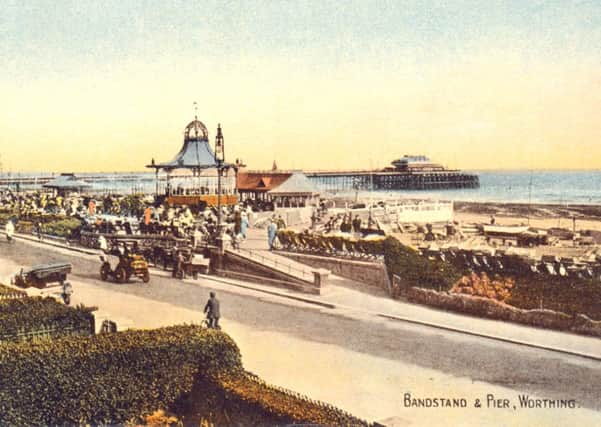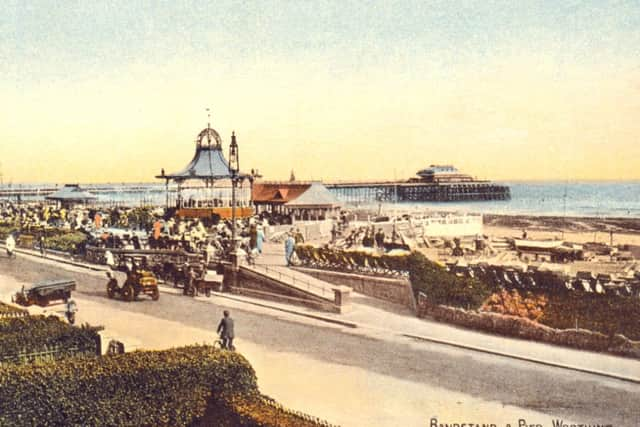The seductive nature of good music – Worthing’s early bandstands


This first bandstand was a modest moveable affair, which – after it was replaced in 1897 with the handsome birdcage bandstand seen in the other pictures that illustrate this article – was for many years in use in Steyne Gardens.
It is perhaps surprising that Worthing did not acquire a more impressive bandstand sooner than it did, for outdoor music was an important feature of Victorian seaside holidays.
Advertisement
Hide AdAdvertisement
Hide AdSince 1897 was the year of Queen Victoria’s Diamond Jubilee, it is reasonable to suppose that the construction of a new bandstand was part of Worthing’s plans for that event.


The bandstand was built by W. Macfarlane at the massive Saracen Foundry, at Possilpark in Glasgow.
Macfarlane was the most important manufacturer of ornamental ironwork in Scotland.
Today, we are used to having as much music as we like at the touch of a button, but in the 19th century there was no television or radio, and the first commercial recordings of music – on “cylinders” – were not available until the start of the 20th century.
Advertisement
Hide AdAdvertisement
Hide AdMusic was something you made for yourself at home or at the local inn; or paid to hear in concert halls or music halls; or went to listen to – usually free of charge – in parks and public places.
Oddly, the band that played inside the old moveable bandstand on Worthing seafront was – certainly as late as 1894 – a purely string band, rather than one that included brass instruments; and a letter printed in the Worthing Gazette on August 22 that year expressed the view that musical provision in Worthing was inferior to that in at least one rival Sussex resort.
The letter was from a certain W. Hurran, of 110 Beresford Road, Harringay Park, London.
Under the heading “A Well-Intentioned Grumble”, W. Hurran starts by complaining about the charges levied to stroll along the pier and listen to music in the pavilion at the sea-end – those at Hastings, he says, being lower.
Advertisement
Hide AdAdvertisement
Hide AdHe then turns his attention to Worthing’s town band: “Then again, the Town Band. Good music, in my opinion, is more seductive in inducing people to visit a place than anything else.
“I would not for a moment attempt to throw cold water on the efforts of those now engaged, but there is not half enough of them; besides, a string band, without it is of very great strength, is not suitable for outdoor performances.
“Here, again, a leaf might well be taken out of Hastings’ book, which supports a strong military band by a grant from the town and voluntary subscriptions.”
In 1897, to coincide with the new bandstand, a new town band was formed, and this probably included brass instruments.
Advertisement
Hide AdAdvertisement
Hide AdBut within ten years it had folded, and after that only visiting bands used the bandstand.
As with the pictures for the recent article about the pier kiosks (Looking Back, July 24), all the illustrations of the 1897 bandstand that accompany this article are old postcards.
The reason for this is that, as in the case of the kiosks, the bandstand featured on scores of different postcard views of Worthing seafront, and these are by far the best images available.
All the views of the birdcage bandstand reproduced here date from before the First World War, with the exception of the postcard which is sixth in the gallery above, which dates from about 1920.
Advertisement
Hide AdAdvertisement
Hide AdThe motorbike seen in this photograph, incidentally, is the vehicle on which the Tunbridge Wells photographer Harold Camburn travelled around Kent and Sussex, taking photographs for the postcards he published under his Wells Series imprint.
He included his motorbike on a number of his postcards as a sort of signature.
Three of the cards in the gallery above are by Camburn, the other two being the fourth and ninth cards.
For the first ten years of the birdcage bandstand’s existence there was nowhere for any of the audience to shelter from the rain.
Advertisement
Hide AdAdvertisement
Hide AdThen, in 1907, a shelter was erected to the south of the bandstand. This can be seen on five of the photographs.
The birdcage bandstand survived for less than 30 years. In 1925 it was replaced with a new bandstand and a large enclosure, as part of the ambitious Adshead & Ramsey project that also included the new land-end pier pavilion (see Looking Back, September 25).
• Antony Edmonds’s new book, ‘Oscar Wilde’s Scandalous Summer: The 1894 Worthing Holiday and the Aftermath’ (normal price £20), is available until December 20 at the VisitWorthing Information Centre, at the Dome, for the special price of £15. Go to the VisitWorthing shop and quote: “Oscar & Herald”.